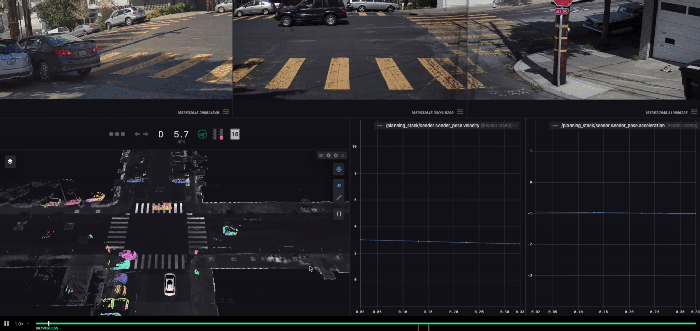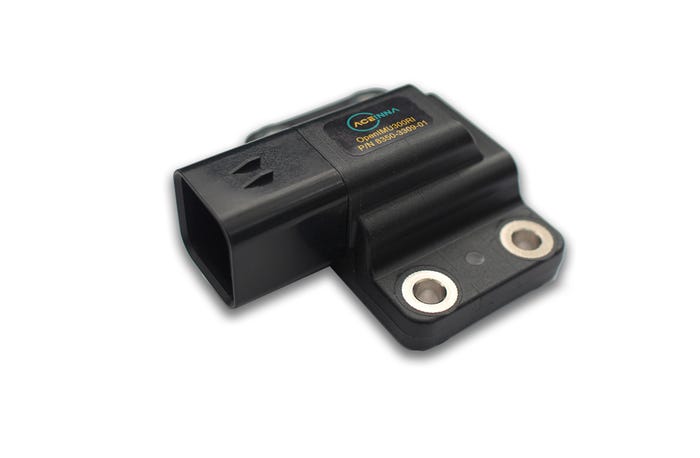There's a growing trend of autonomous vehicle developers open-sourcing their software tools and hardware, even for applications outside of automotive.
June 25, 2019
|
Webviz from Cruise allows developers to create custom, web-based visualizations of data from autonomous vehicles and robots (Image source: Cruise) |
GM Cruise is turning loose its tool for autonomous vehicle visualization to the open source community for a wider range of applications, including robotics and automation. But its only the latest in a series of similar developments to happen over the course of the year.
This time the General Motors-owned Cruise is open-sourcing Webviz – a web browser-based tool for data visualization in autonomous vehicles and robotics. Webviz is an application capable of managing the petabytes of data from various autonomous vehicle sensors (both in simulation and on the road) and creating 2D and 3D charts, logs, and more in a customizable user interface.
Cruise is making that tool available to engineers in the autonomous vehicle space and beyond. “Now, anyone can drag and drop any [Robot Operating System (ROS)] bag file into Webviz to get immediate visual insight into their robotics data,” Esther Weon, a software engineer at Cruise, wrote in a Medium post.
Over the last year since it was first developed, Webviz's user base has grown to a diverse range of over a thousand engineers, including autonomous vehicle engineers, machine learning engineers, and QA engineers, according to Cruise.
“As we built out Webviz to support many teams’ different workflows, we found that many of its benefits were not specific to Cruise, resulting in our decision to open source it as a general robotics data inspection tool,” Weon wrote, “For this initial release, we settled on a suite of general panels that any robotics developer can leverage to explore their own data, with minimal setup. We hope the robotics community can use Webviz to enjoy this out-of-the-box data exploration and insight.”
Cruise is only the latest in a number of autonomous vehicle companies who have been releasing their tools into the open source community. Uber Engineering has open-sourced several of its tools, including its Autonomous Visualization System.
Earlier this year, Cruise itself also open-sourced its JavaScript library for reading ROS bag files, as well as Worldview, a library for generating 2D and 3D scenes for autonomous vehicle visualizations.
New Open Datasets
Last year, sensor company FLIR systems released a dataset of over 10,000 thermal images for autonomous vehicles for use by the larger developer community to test and train self-driving vehicles.
In conjunction with these datasets, FLIR has recently announced the FLIR Thermal Imaging Regional Dataset program for machine learning advanced driver assistance development (ADAS) and autonomous vehicle systems. The company is actively collecting thermal data from major US cities for various weather and road conditions and is planning on releasing city-specific datasets to developers, with San Francisco being the first city.
“Creating datasets takes time and resources, and the datasets FLIR has created empower the automotive community to more quickly evaluate thermal sensors on next-generation algorithms,” Frank Pennisi, President of the Industrial Business Unit at FLIR, said in a press statement. “When combined with visible light cameras in an automatic emergency braking (AEB) system, the thermal data will create a more comprehensive, redundant, and safer system in cars today. Then in the near future, when thermal is fused with visible, LiDAR, and radar, thermal sensor data, paired with machine learning, this will create a more comprehensive, redundant, and safer system for identifying and classifying roadway objects, especially pedestrians and other living things in an autonomous driving mode.”
Open Hardware for Automotive
|
The OpenIMU300RI is an open-source IMU for autonomous vehicles, robotics, and other applications. (Image source: Aceinna) |
There are also developments happening on the hardware end. Earlier this month, Aceinna, a sensor solutions company, released the OpenIMU300RI, an open-source inertial measurement unit (IMU) for autonomous vehicle as well as robotics, construction, and agriculture applications.
By open-sourcing its IMU hardware Aceinna is aiming to give engineers a robust sensor solution they can apply across a variety of industries. Whereas closed solutions prevent engineers from fully optimizing their algorithms for a specific platform, the idea of an open-source IMU is to change that.
“Different vehicle platforms have different dynamics,” James Fennelly, Product Manager at Aceinna explained. “To get the best performance, the attitude, navigation, or other algorithm needs to be tailored for each vehicle platform and application. The OpenIMU300R gives designers a flexible and simple-to-integrate IMU solution that can be easily optimized for a wide range of vehicles and applications.”
RELATED ARTICLES:
Delayed Due to Testing
Difficulties in testing autonomous vehicles have played in a key factor in major automakers rethinking their timetables on the delivery of fully-autonomous vehicles. Simulation is becoming an increasingly common solution in the face of time-consuming real-world road tests. But simulation comes with its own challenges – particularly around data and analysis. A robust autonomous vehicle is going to have to be intelligent enough to navigate and respond to all of the myriad of conditions that a human could encounter – everything from bad weather and road hazards to mechanical failures and even bad drivers.
To create and train vehicles to deal with all of these scenarios requires more data than any one company could feasibly gather on its own in a reasonable time frame. Toyota, for example, has gone on record stating it believes it will have to test its self-driving cars for 8.8 billion miles before they are safe enough to be deployed in the real world.
By open sourcing their tools, companies are looking to leverage the wider community to take part in some of the heavy lifting. After all, as various sensor companies and automotive technology startups have demonstrated in the past, the major breakthroughs may not necessarily come from the big-name OEMs. The autonomous vehicle problem is not an easy one to solve – especially when the goal is Level 5 autonomy. Why not let as large of community of developers as possible take a crack at it?
As Cruise's Weon wrote, “...We are reminded daily that much of our technology could not have been built without the help of countless invaluable open source resources. We hope our own contributions will help others in the community build the next generation of visionary technology.”
Chris Wiltz is a Senior Editor at Design News covering emerging technologies including AI, VR/AR, blockchain, and robotics.
Drive World with ESC Launches in Silicon Valley This summer (August 27-29), Drive World Conference & Expo launches in Silicon Valley with North America's largest embedded systems event, Embedded Systems Conference (ESC). The inaugural three-day showcase brings together the brightest minds across the automotive electronics and embedded systems industries who are looking to shape the technology of tomorrow. |
About the Author(s)
You May Also Like






